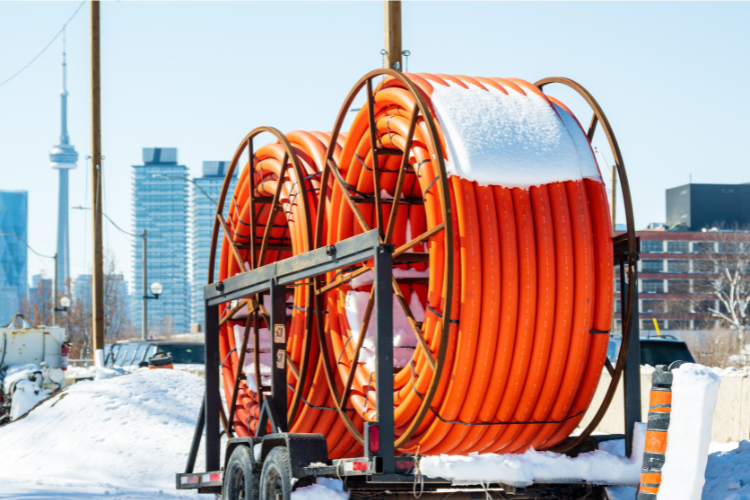When you think of an industry conference, it’s easy to picture a sea of vendor booths and product pitches. And while vendors do play a critical role in the buildout process (after all, you can’t build a fiber network without fiber), the exhibit hall at Fiber Connect 2025 was much more than a marketplace—it was a learning space. From hands-on demos and discussion salons to a smart home theater, the show floor offered attendees a chance to dig into every corner of the fiber ecosystem.
Of course, it wasn’t all business. I won a prize from a claw machine, gave a punching machine my best shot (spoiler alert, I didn’t win), and spent time chatting with attendees about their experiences. I also had some great conversations with other vendors—because at the end of the day, we’re all working toward the same goal: moving our networks forward.

Beyond the floor, sessions tackled the challenges and opportunities shaping the future of fiber. Here’s what stood out most.
Rethinking the middle mile
The term “middle mile” might sound straightforward, but its meaning shifts depending on the application. I heard it described as both a mostly fixed broadband access network and the critical link between core infrastructure and last-mile connections, especially in rural areas. Regardless of the definition, one thing is clear: demand is increasing, and we must ensure capacity doesn’t fall far behind.
That makes the way we design these networks more important than ever. Building with the future in mind means focusing on resilience, redundancy, and scalability. We have to be mindful of supporting not just current needs but tomorrow’s technologies. And while the goal is shared, no two middle mile networks look alike. Some allow for service drops along the main line; others reach into remote areas where infrastructure is sparse, requiring a very different strategy.
Then there’s the matter of funding. It’s a complex landscape, with funding stitched together from a variety of programs. Programs like the Broadband Equity, Access, and Deployment (BEAD) program1, the USDA’s ReConnect Program2, and the Rural Digital Opportunity Fund (RDOF)3 each come with their own rules, timelines, and fine print.
With so many moving parts, aligning efforts across programs can be a challenge, but strategic partnerships are making it more achievable. From public-private efforts to new alliances with electric utilities, collaboration is becoming the real foundation for rural expansion.
One standout example is California’s Middle-Mile Broadband Initiative4, led by CENIC through its GoldenStateNet project. With over 10,000 miles of open-access infrastructure planned, the initiative aims to connect rural, tribal, and underserved communities by combining public funding with CENIC’s technical expertise.
So, what’s the main takeaway? Funding cannot be treated as a siloed effort, nor is it a panacea for rural deployment. Without coordination at the state and provider level, disconnected programs could ultimately slow progress rather than accelerate it.
Managing complexity without losing momentum
As networks grow in scale and sophistication, the demands of project management grow right alongside them. That’s why panelists in the session Managing the project, promoting the value stressed the importance of planning ahead to avoid downtime. Allocating proper lead times, securing right-of-way access early, and staying proactive on permitting can keep projects on track and teams productive. With service-level agreements to uphold and delivery timelines getting tighter, a reactive approach won’t cut it much longer.
The conversation also touched on infrastructure design in light of emerging technologies. As artificial intelligence applications become increasingly latency-dependent, the physical location of internet exchange points (IXPs) will matter even more. Networks will need to be designed not just for reach, but for proximity—supporting applications where milliseconds make a difference.
There were a few lighter moments too, like the fact that OTDR testing is now accurate down to a single meter. It’s a small reminder that even the tools we rely on are evolving quickly, and fiber strategies need to evolve with them. With projections pointing to 75 billion connected devices by 2060 (as stated by panelist Chris Bailey, Director of Sales at Wesco), future-proofing decisions made today is crucial.
One of the session’s parting reminders: You’re about to spend a lot of money. Be smart when making decisions—educate, communicate, and talk about issues.
Don’t forget about teamwork
One of the most relatable sessions, Building cohesive teams that support scale and success, focused on the human side of network delivery. The message was clear: no matter the size or structure of an organization, working in isolation just doesn’t work.
The definition of “team” came up often, and it reached far beyond internal departments. Panelists encouraged including permitting offices, local governments, contractors, customers, and even cities as part of the broader delivery ecosystem. Success, they agreed, depends on trust, transparency, and a willingness to overcommunicate when it counts.

That kind of collaboration starts with investing in our internal teams. Agility, curiosity, and a strong eagerness to learn were called out as key traits for long-term growth. Cross-training was also highlighted as a smart way to build flexibility and keep teams adaptable. That investment includes setting SMART goals, aligning people with the right roles, and fostering a culture where continuous learning is the norm.
What’s my key takeaway? If we want our teams working in harmony (whether internal or external), we’ll need a clear-cut mission and vision.
From funding to the fundamentals of fieldwork, the conversations were as practical as they were thought-provoking. If you’re heading home from Fiber Connect with a notebook full of ideas and even more questions than before, you’re definitely not alone.
The conversations sparked last week are far from over, and that’s a good thing. Let’s keep the momentum going. Give us a shout if you have any questions about networks, teamwork, or anything in between.
Citations:
1 National Telecommunications and Information Administration. “Broadband Equity, Access, and Deployment (BEAD) Program.” BroadbandUSA. U.S. Department of Commerce. Accessed June 6, 2025. https://broadbandusa.ntia.gov/funding-programs/broadband-equity-access-and-deployment-bead-program.
2 U.S. Department of Agriculture. “ReConnect Loan and Grant Program.” USDA.gov. Accessed June 6, 2025. https://www.usda.gov/sustainability/infrastructure/broadband/reconnect-loan-and-grant-program.
3 Federal Communications Commission. “Auction 904: Rural Digital Opportunity Fund.” FCC.gov. Accessed June 9, 2025. https://www.fcc.gov/auction/904.
4 California Department of Technology. “Middle‑Mile Broadband Initiative.” Middle‑Mile Broadband Initiative. Accessed June 9, 2025. https://middle-mile-broadband-initiative.cdt.ca.gov/.



